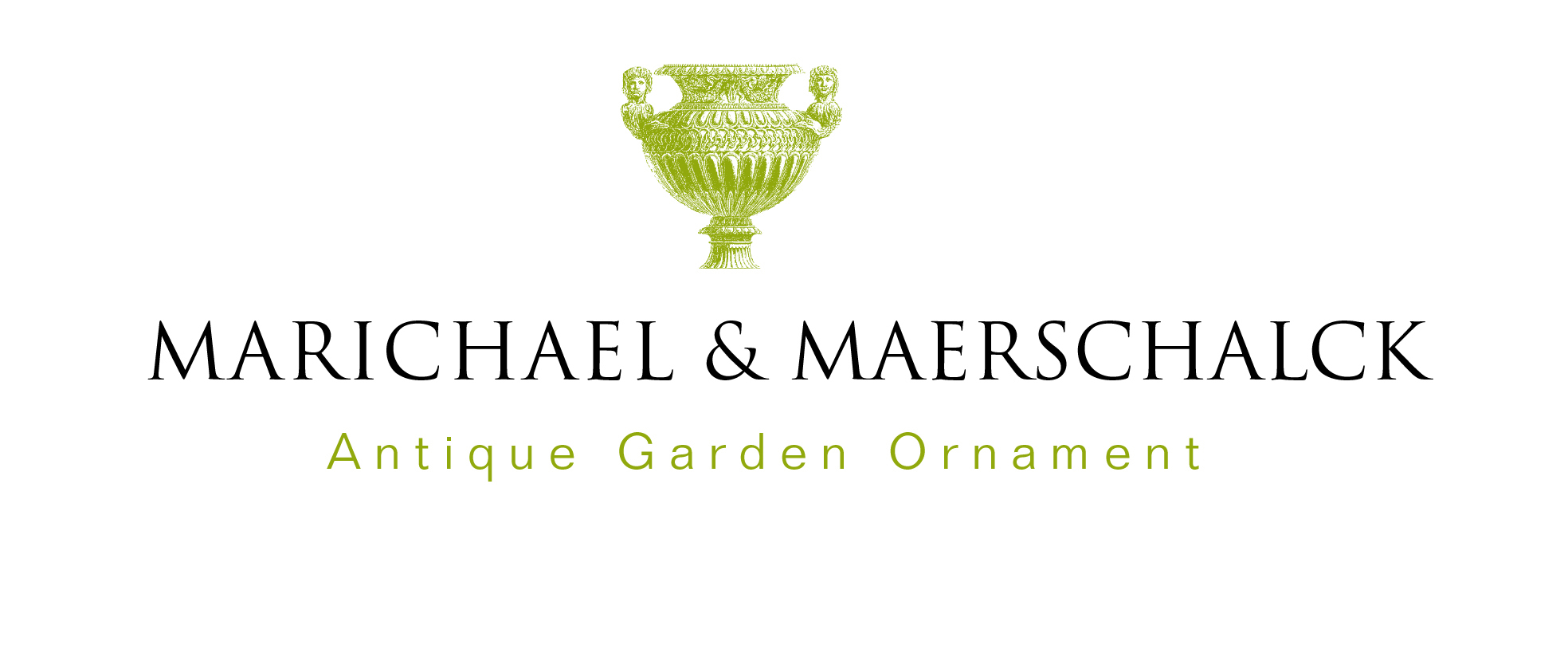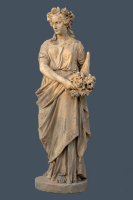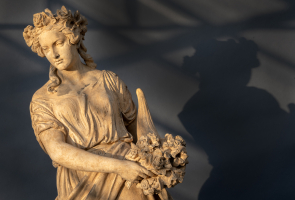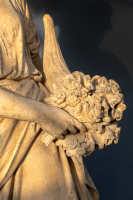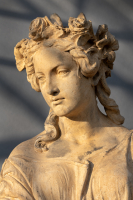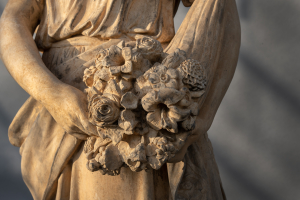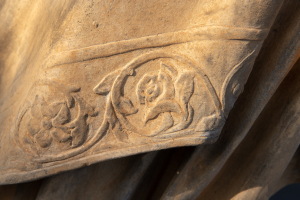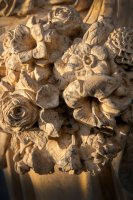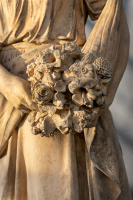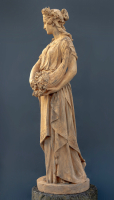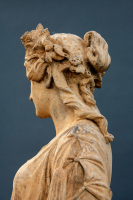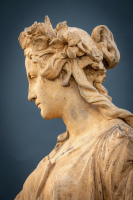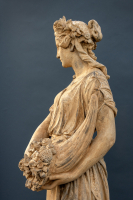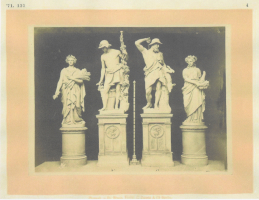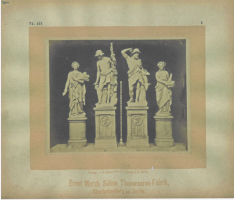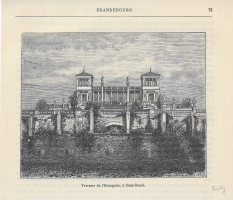- Home
- A mid 19th century terracotta statue of Flora
A mid 19th century terracotta statue of Flora
A 19th century terracotta sculpture depicting Flora, executed by the German firm Ernst March & Söhne, Berlin-Charlottenburg; after a model by the Berlin sculptor Julius Franz, is stamped 1870.
Sculpted all around, neoclassical statue: striding on a round pedestal, in a cloth floor-length in antique style and preciously trimmed, she holds a cornucopia in both hands against her left hip from which abundant flowers spring, with a wreath of rose petals on her head, see catalog Ernst March Thonwaaren Fabrik, Charlottenburg bei Berlin, Berlin, 1870, pag. 4 (see photograph); also pag. 16, under nr. 70 Frühling (Flora).
The initial pottery and later earthenware factory founded in 1836 by Ernst March (1798-1847) founded in Charlottenburg, was one of the largest and most renowned factories specialising in terracotta. In addition to garden and park sculptures, the company produced a variety of architectural ceramics which survive to this day on many important public buildings in Berlin: the Red Town Hall (Rotes Rathaus), the Martin-Gropius-Bau (Berlin Museum of Decorative Arts), Görlitzer Bahnhof, the Neues Museum and the Friedrichswerdersche Kirche.
Until around 1860 there were two high marble columns on the terraces of the orangery of the Sanssouci Palace in Potsdam, topped with terracottas of (cf. the statue at issue) Flora and Ceres by E. March. We know it's the same Flora from the 1869 catalogue: table 4, price list page 16 no. 70 Frühling (Flora) and no. 71 Sommer (Ceres), both 1.60 m high. These columns and statues have now disappeared. (See Berliner Terrakottakunst des 19. Jahrhunderts by Katharina Lippold, ed. Brother Mann Verlag, Berlin; pages 152-153, Fig. 87). See also photograph attached.
Currently, in Sanssouci one can find e.g. the baldachin fountain and a muse group by March still standing.
Around 1896, the Ernst March & Söhne factory employed 150 workers and consumed 1,500 tonnes of clay annually.
Dimensions: 161 cm high, diameter pedestal 50 cm
Condition: good condition, minor restorations
Reference: SCH122022/2153
Further reading:
FLORA
In Roman mythologie, Flora was a goddess of flowers and the season of spring. While she was otherwise a relatively minor figure in Roman mythology, being one among several fertility goddesses, her association with the spring gave her particular importance at the coming of springtime. Her festival, the Floralia, was held between April 28 and May 3 and symbolised the renewal of the cycle of life, drinking, and flowers. The festival was first instituted in 240 B.C.E but on the advice of the Sibylline books she was given another temple in 238 B.C.E. Her Greek equivalent was Chloris. Flora was married to Favonius, the wind god, and her companion was Hercules. Her name is derived from the Latin word flos which means flower. In modern English, Flora also means the plants of a particular region or period. Flora achieved more prominence in the neo-pagan revival of Antiquity among Renaissance humanists han she had ever enjoyed in ancient Rome. Source: Wikipedia
JULIUS FRANZ (1824 - 1887)
Already at the age of 14 years Julius Franz was educated under Ludwig Wilhelm Wichmann and Ferdinand August Fischer, at the Berlin Academy of Arts. Following the Golden Medal of the Berlin Academy, he undertook the Grand tour in 1850. Julius Franz primarily performed commissioned work in the field of decorative arts. For example he created the now lost personifications of England and America for the Berlin stock exchange. To his most important works belong the monumental marble groups, after drafts of his teacher August Fischer, for the Belle-Alliance-Platz in Berlin.
ERNST MARCH & SÖHNE
Ernst March Söhne, or Ernst March & Sons is a private firm, whose works and offices are at Charlottenberg, once a suburb, but now a portion of Berlin. The works were established in 1836 by the grandfather of Albert March, who took the business over on the 1st of January 1899 from his father and uncles. For a long time the only product of the works was high art terra cotta, and so beautiful was it that the reputation of March & Sons stood deservedly higher than that of any other maker of terra cotta in the world.
The March & Sons’ works are the most artistic in themselves that I have ever seen anywhere. They would afford a very useful object lesson to several terra cotta manufacturers I have in mind, whose works are mere factories of the homeliest description and sometimes show that the pursuit of the nimble dollar does not even leave time for sweeping the floor. It is said that “Who drives fat oxen should himself be fat”, and the man who makes things of beauty, which he invites other men (architectes and possible purchasers) to come and see, should have his surroundings somewhat in agreement with the high art he professes to produce. The contrary of this is just as incongruous as it is for the maker of bricks and tiles to live in a wooden shanty with a single rooi.
.../...
The terra cotta of all the magnificent buildings that I saw in Berlin appeared to have been made by March, such as the Church of the Holy Cross, the arcade and very many others. Although the manufacture of high art terra cotta was a profitable industry and there was an ample demand for the ware, from abroad as well as at home, including South America for religious figures, the increasing demand for refractory ceramic ware, for chemical and other purposes, and the considerably greater profit from this, tempted the firm to take up this work.
While terra cotta is stil made the manufacture of ceramic apparatus for the chemical industries, for electrical work, for galvanic and electro plating establishments, and for laboratories, etc., has been receiving more and more attention each year, since about 10 years ago when it was first undertaken.
‘Brick and Clay Record’ (USA) - Volume II, Issue 4; 1899
Antieke Tuinornamenten
Viooltjesdreef 39031 Baarle-aan-de-Leie
info@antieke-tuinornamenten.be+32 (0) 9 282 20 97+32 (0) 475 53 41 63
Opening hours
Bezoek aan de tuin enkel na afspraak.
